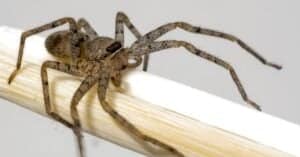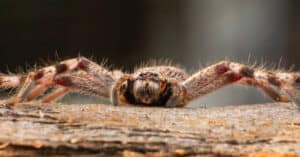Almost everyone has encountered these creepy little eight-legged arachnids in their houses. Whether you’re from Louisiana or just passing through, you might be wondering if spiders are dangerous here. While the majority of spiders in Louisiana are harmless and do not bite, a handful is known to be deadly to humans. They are usually shy of human interaction, but they will attack and inflict harm with their venom if they feel threatened. Louisiana has roughly 30 to 40 species of spiders dispersed across the state, with the majority prospering in the southeastern region. For spiders, that’s a terrible number! Fortunately, only five of these species are harmful or lethal and should be avoided at all costs. But which are Louisiana’s most dangerous spiders, and how will you know if you have encountered one?
Of the numerous spider species lurking throughout the Bayou State, only five of them are dangerous. These include the brown widow, the brown recluse, the black-footed yellow sac spider, and two species of the black widow. These venomous spiders have been known to induce various symptoms ranging from mild to severe, necessitating rapid medical intervention. Because they venture indoors in search of food and shelter, and their bites are the most potentially dangerous to humans, the black widow and brown recluse spiders are the deadliest spiders you’ll likely encounter among Louisiana’s venomous spider species. But given the similar features of spiders, it may be difficult to spot which are venomous and which aren’t, especially if you are no expert. This article will discuss Louisiana’s 5 most dangerous spiders this summer and how to spot them.
Louisiana’s 5 Most Dangerous Spiders
1. Brown Widow
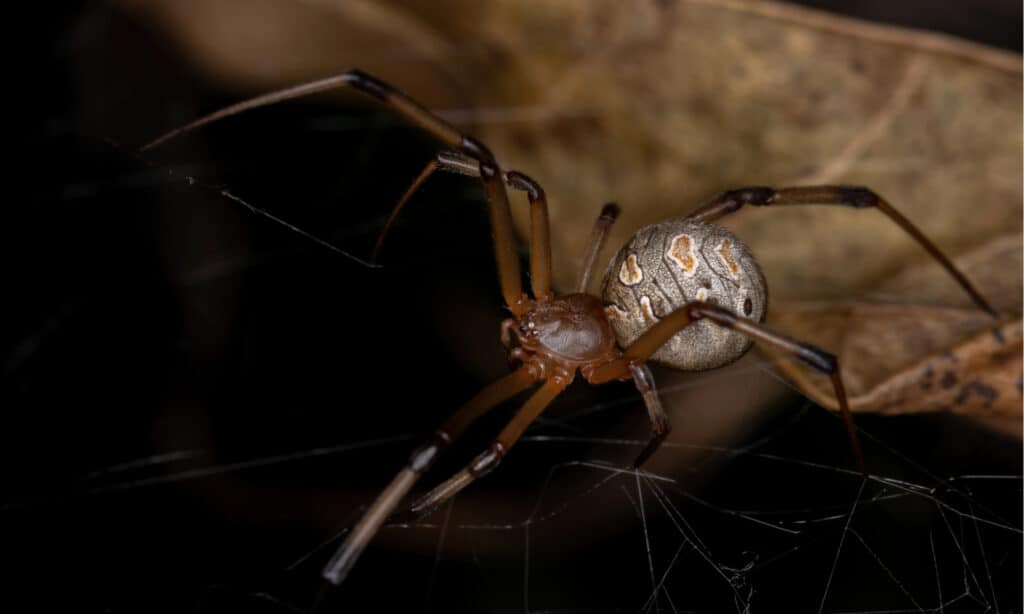
Unlike black widows, brown widows are tan to dark brown.
©Vinicius R. Souza/Shutterstock.com
Brown widow spiders are not native to Louisiana. They’re thought to have come from either Africa or South America. As an invasive species, they are now found throughout the world, usually near buildings in warmer climates. The brown widow spider is a worldwide tropical and subtropical spider with populations in Hawaii, Florida, Australia, South Africa, sections of the Caribbean Islands, Japan, and Cyprus.
How to Spot: Appearance
Brown widows aren’t as well-known as black widows, but they’re still one of Louisiana’s most dangerous spiders. Brown widows, unlike black widows, are tan to dark brown. Their cephalothorax is dark brown, and their legs include tan, black, and brown segments. The brown widow’s most distinctive characteristic is its cream-colored abdomen with distinguishing patterns. An orange hourglass marking, similar to the red hourglass of the black widow, can be found on the underside of the abdomen. Brown widow spiders can reach a length of half an inch to a full inch.
How to Spot: Habitat
Brown widow spiders are commonly seen in populated areas, hiding beneath patio furniture or playsets and preferring darkness.
Venom
Even though the venom of brown widow spiders is twice as strong as that of black widow spiders, this species is the least deadly on our list. Because the brown widow spider only injects a small amount of venom in each bite, the toxin’s effects on humans are usually minor. They are, nevertheless, deadly due to their neurotoxic venom, which can act on nerve endings and create latrodectism-like symptoms similar to those found in black widow bites. Despite the fact that they are less dangerous, you should avoid coming into contact with them.
2. Brown Recluse
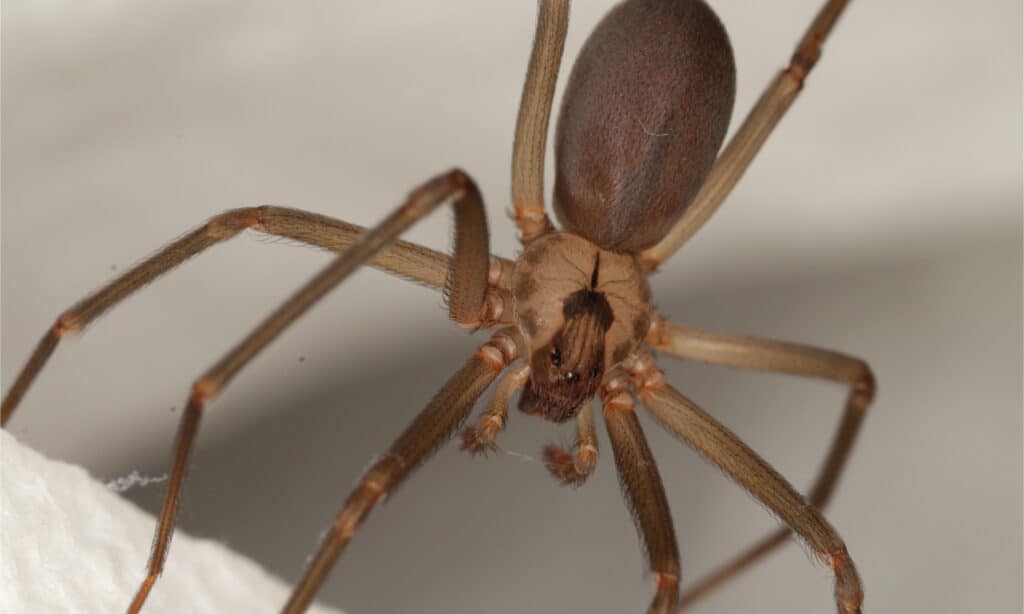
Brown recluse spiders are the most venomous spiders in North America.
©Nick626/Shutterstock.com
While there are more than a dozen species of recluse spiders in the United States, only the most notorious brown recluse is native to Louisiana. The brown recluse spider’s bite is perhaps its most remarkable trait. This spider is one of America’s most feared spiders, and it’s easy to see why. The brown recluse is regarded to be the most venomous in North America. Its “violin spider” epithet refers to a distinctive feature on the brown recluse’s large, almost heart-shaped cephalothorax: a violin-shaped patch.
How to Spot: Appearance
Brown recluse spiders have pale brown violin-shaped patterns on the dorsal side of their cephalothorax and range in color from white to dark brown or darkish gray. While most spiders have eight eyes, the three pairs of eyes on the brown recluse make it easy to identify (six eyes). The brown recluse spider is significantly smaller than the black widow spider. Brown recluse spiders, for example, can be anywhere from a quarter of an inch to 3/4 of an inch long, whereas black widow spiders can be anywhere from one to two inches long. One fascinating fact about the brown recluse spider is that it may self-amputate a limb to escape a predator or prevent the venom from spreading throughout the body. However, it does not regrow the leg and compensates for the loss by walking with an uneven gait.
How to Spot: Habitat
Brown recluse spiders prefer dark, remote areas to hide in. Because of their solitary nature, these spiders prefer to weave their webs in cardboard, woodpiles, sheds, closets, garages, cellars, and other secluded areas.
Venom
Brown recluse bites are dangerous because they contain necrotic and hemotoxic venom. Brown recluse spiders are rarely aggressive, attacking only when their isolated environments are disturbed, and when they feel threatened. The symptoms of their bite, on the other hand, can vary but usually include a painful, itching sore that gets necrotized and takes months to recover. The majority of fatalities occur in children and the elderly.
3. Northern Black Widow
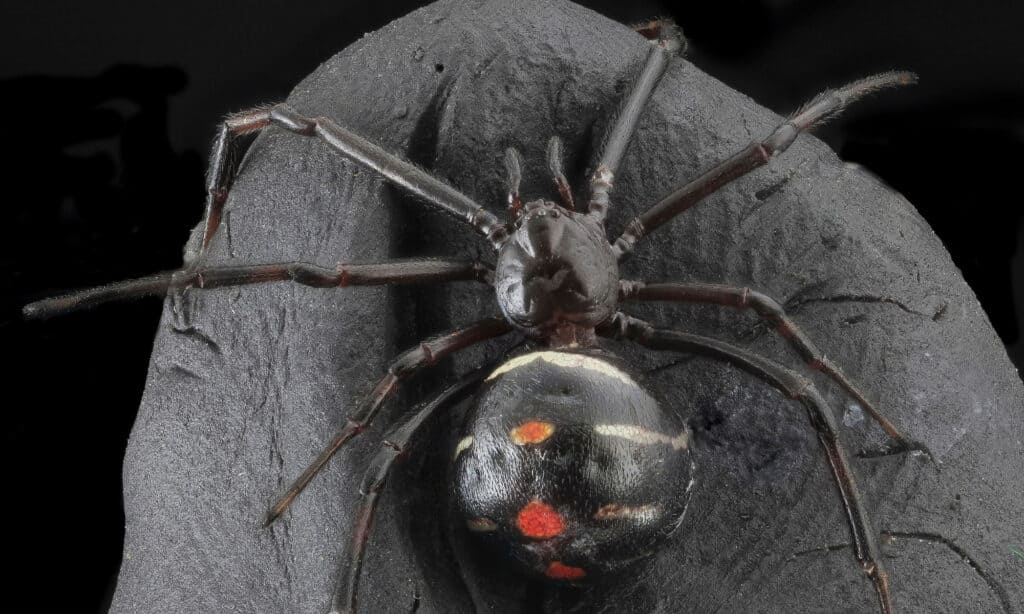
Unlike other black widows, northern black widows have a broken hourglass-shaped marking on their abdomens.
©Porco_Rosso/Shutterstock.com
Without the renowned black widow, no list of deadly spiders in North America would be complete. The northern black widow, the western black widow, and the southern black widow are three separate species of black widow. But only the northern and southern black widows are found across Louisiana.
How to Spot: Appearance
The northern black widow spider grows about 0.16 to 0.4 inches long. Unlike its southern relative, it has a fractured hourglass mark and a disconnected, thinner central region frequently showing visible red spots. The hourglass marking on the southern black widow, on the other hand, is complete.
How to Spot: Habitat
Northern black widows weave three-dimensional webs and prefer dark, enclosed spaces with numerous attachment sites. Black widow spiders can live in man-made constructions, including colonial stone walls, ditches, and wood heaps.
Venom
Each black widow has a significant amount of highly lethal venom released in minute amounts. A spider bite can produce pain, muscle rigidity, vomiting, and sweating, known as “latrodectism.” Medical intervention is essential in cases of significant discomfort or spreading local redness followed by extreme pain at the injury site. Although their venom is deadly, these spiders are shy and rarely bite. In the United States, a few fatalities have been reported, especially among children.
4. Southern Black Widow
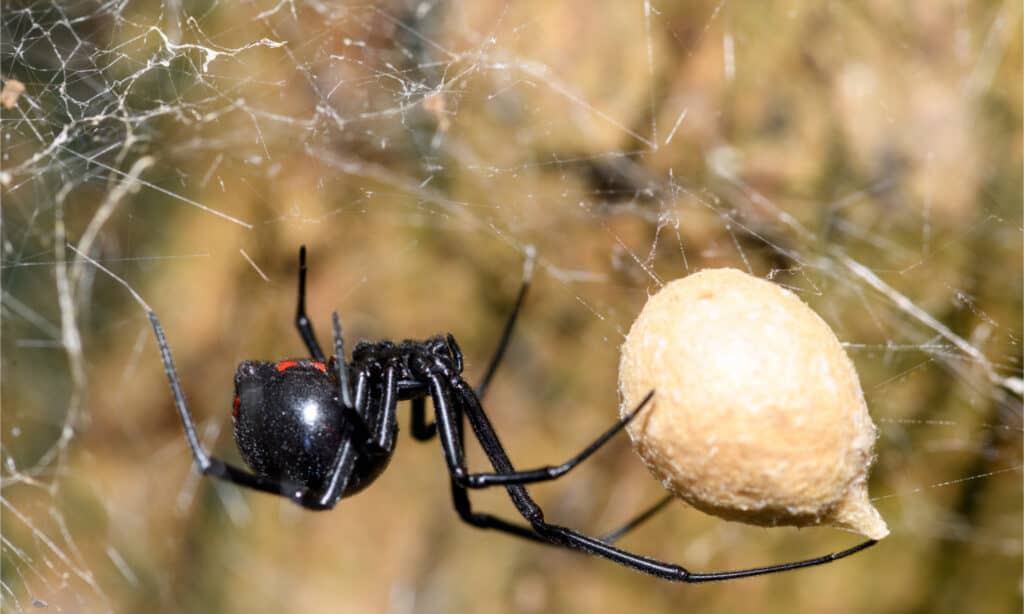
Southern black widow spiders have a brilliant red hourglass marking on the underside of their abdomen and are shiny jet black.
©Jeff W. Jarrett/Shutterstock.com
In Louisiana, black widow spiders are found in urban and suburban regions, and these arachnids are notorious for their deadly attacks. The southern black widow is frequently seen in and near homes, preferring to congregate and create webs in congested areas.
How to Spot: Appearance
Southern black widow spiders have a brilliant red hourglass marking on the underside of their abdomen and are shiny jet black. They usually feature a red dot on the back end of the abdomen just above the spinnerets. Males and youngsters, on the other hand, are purplish to grayish-black with white stripes and yellow/orange dots.
How to Spot: Habitat
Southern black widow spiders are one of the most venomous in the state. They feed mostly on insects and can be found in undisturbed woods, stumps, and stone walls. These spiders live and entangle victims in a three-dimensional web that it produces.
Venom
Because of their huge, needle-like mouthparts, female black widow spiders are more lethal than males. A southern black widow spider’s venom is believed to be about 15 times stronger than a rattlesnake’s! Females are also notorious for consuming their mates after they have reproduced.
5. Black-Footed Yellow Sac Spider

The black-footed yellow sac spider builds a silk sac to protect itself from predators during the day.
©iStock.com/ViniSouza128
Yellow sac spiders are small, with bodies measuring about 1/4 inches long and legs measuring up to one inch long, but they aren’t as timid as black widows. These spiders are typically yellow, as their name suggests, although they can also be light brown or yellow-orange.
How to Spot: Appearance
The black-footed yellow sac spider is a little venomous spider whose name comes from how it looks. The pale yellow-beige body of the spider features dark brown markings on the palps, jaws, and ends of its legs. An orange-brown line also runs down the center of its abdomen. This species is nocturnal, coming out only at night in search of food and mates.
How to Spot: Habitat
Yellow sac spiders live in the forests, as well as in people’s homes and gardens. Although these spiders hunt, they prefer to stay within a few yards of their webs.
Venom
Black-footed yellow sac spiders can bite humans. Since their bites contain venom, a single bite causes moderate discomfort, itching, and swelling that goes away after a few days. Fortunately, they are not a huge threat because they seldom bite. But when they do, the venom is mild and rarely causes serious reactions. Whatever the case, this is not a spider to mess with.
The photo featured at the top of this post is © Decha Thapanya/Shutterstock.com
Thank you for reading! Have some feedback for us? Contact the AZ Animals editorial team.




